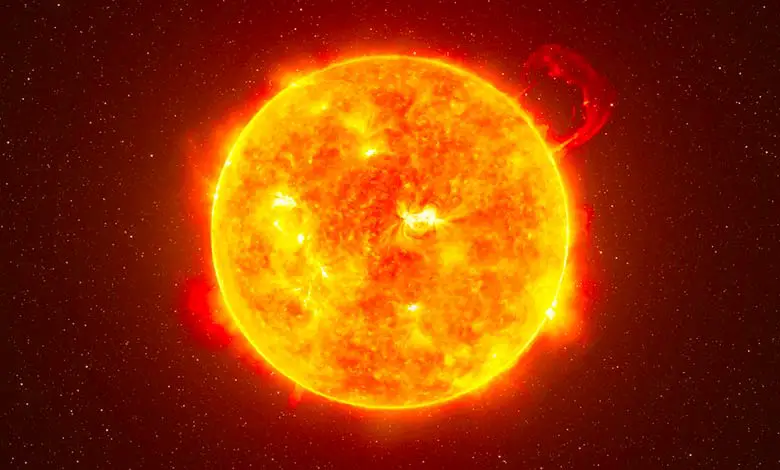
Hello, fellow space explorers and curious thinkers! Have you ever found yourself basking in the sunlight, pondering what exactly the sun is made of? Is it a gigantic ball of fire, as many tales and myths suggest, or is there more to this celestial giant than meets the eye? The sun’s brilliant glow and life-giving warmth are pivotal to our existence, yet its true nature remains a fascinating enigma to many.
What is the Sun? Some people say it’s a giant ball of fire, but this isn’t true. It is a metaphor. The Sun is the nuclear furnace, but what you believe with science is unimportant. Could the Sun be a ball of fire, something burning out in space? What is fire?
Fire combines with oxygen in the air, a process that is called combustion. It produces heat and light. There’s no air and oxygen in the sun. The Sun fuses and takes some hydrogen atoms and turns them into helium atoms, spitting out the extra energy. It is a big ball of gas and plasma.
We’re setting off on an illuminating expedition to uncover the reality of our solar system’s star. Strap in and prepare for a journey of discovery as we delve into the science behind the sun’s composition and debunk some of the most common misconceptions. Let’s light up our understanding of the universe together!
Is the Sun a ball of fire?
In the 1890s, atomic processes like radioactivity were discovered by Madame Curie and others in the early 20th century. They realized the Sun was a nuclear furnace. It isn’t burning with a chemical process like combustion at all.
The Sun combines two hydrogen atoms into an atom of helium and gets off light and energy. The core in the very center is very similar to a nuclear reactor. These particles get squashed together, and there’s massive pressure. Also, they undergo chemical reactions. So there are very different layers towards the edge of the sun.
What is the difference between a space fire and an earth fire? On Earth, fire is under the Dominion of gravity. Think of a candle as the fire consumes the oxygen and heats the air. The hotter air rises, and the heavier, cooler, unburned air sinks, replenishing the fire fuel.
In space, this cycle doesn’t happen. There’s no such thing as lighter or heavier air in microgravity. Thus, the fire heats the air around the flame, causing it to burn slowly like smoke. It also means the flame burns equally in all directions, forming a globe instead of flickering.
Flames in space can burn more slowly, coolly, and with less oxygen because of this fire in space, given the right conditions. It can expand in any direction as quickly as it can give us the nearby oxygen. The heat doesn’t cause any rushing air, shockwaves, or anything like Earth. The flame extinguishment or flex experiments explored how fire behaves in microgravity.
Sun ignited its solar furnace about 4.5 billion years ago and has enough fuel to keep burning for another 4-5 billion years. Nuclear fire won’t go out, and the Sun is the source of all energy on Earth. The sunshine powers all photosynthesis, which makes every plant on Earth grow. Everything in the food web is powered by the Sun, created by the Sun.
- So, The sun can’t be a ball of fire because there’s no oxygen in space.
It generates light but also a tremendous amount of energy. It sends all this material to Earth, so we live in the sun’s extended atmosphere. The heat shield has to remain pointed toward the sun at all times. So, the front of the heat shield will reach about 2,500 degrees Fahrenheit. But the spacecraft’s main body is nice and cool at about 80 degrees Fahrenheit.
The sun has a magnetic field that is continually moving away. The Parker Solar Probe found this magnetic field reverses and makes an “S” shape. Astronomers call that a switchback. It’s hard to twist a magnetic field. It’s like trying to twist a rubber hose! Somehow, this energy enters the magnetic field, causing this “S” shape. It lets all this excess energy out into the solar wind when it releases.
We’ve journeyed through the heart of our solar system and shed light on the true essence of the sun. It’s not a mere ball of fire as folklore might suggest, but a complex and dynamic sphere with its own set of extraordinary characteristics. Our exploration today has hopefully brightened your understanding of the sun and sparked even more curiosity about the wonders of space.
The universe is brimming with mysteries waiting to be unraveled, and each discovery brings us closer to grasping the vastness of our cosmic backyard. Thank you for joining me on this enlightening adventure. Keep gazing at the stars, and never stop wondering about the marvels that lie beyond our blue planet. Until next time, keep your eyes on the skies and your hearts filled with wonder!
More Articles:
What Would Happen If The Sun Died?
References:
Pitjeva, E. V.; Standish, E. M. “Proposals for the masses of the three largest asteroids, the Moon–Earth-mass ratio and the Astronomical Unit.”
Williams, D.R. “Sun Fact Sheet.” NASA Goddard Space Flight Center.
Zombeck, Martin. Handbook of Space Astronomy and Astrophysics 2nd edition. Cambridge University Press.
Asplund, M.; Grevesse, N.; Sauval. “The new solar abundances – Part I: the observations.” Communications in Asteroseismology.

